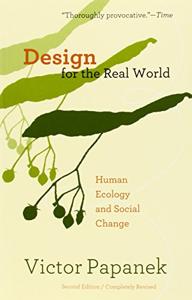
Want to learn the ideas in Design for the Real World better than ever? Read the world’s #1 book summary of Design for the Real World by Victor Papanek here.
Read a brief 1-Page Summary or watch video summaries curated by our expert team. Note: this book guide is not affiliated with or endorsed by the publisher or author, and we always encourage you to purchase and read the full book.
Video Summaries of Design for the Real World
We’ve scoured the Internet for the very best videos on Design for the Real World, from high-quality videos summaries to interviews or commentary by Victor Papanek.
1-Page Summary of Design for the Real World
Overview
Have you ever bought a new expensive piece of equipment only to have it break down quickly? Did you feel like someone was trying to make sure that they get your money by designing the product in such a way that it breaks so soon after you buy it?
If you’ve ever wondered about the quality of things in your life, then Design for the Real World can help. The author gives a brutally honest account of how design has been done wrong and contributed to low-quality consumer goods that are produced today.
In this article, the author is very critical of modern design. He points out how designers have contributed to environmental destruction and suggests that they should change their approach by producing simple products rather than ones with lots of fancy features. The author also provides many practical examples for how designers can refocus their efforts on designing positive products instead of destructive ones. In these key points, you’ll learn why sometimes it’s better to produce a simple radio rather than one decked out with all the latest gadgets, how it could be worthwhile to put a positive spin on waste, why watching Saturday morning cartoons can be seriously dangerous for children’s health, and why the super affluent sometimes buy chairs that are super uncomfortable.
Big Idea #1: More than beauty: design produces functional tools and objects for human society.
When people hear the word design, they think of fancy chairs and high fashion. Design is mostly associated with product design and making things look beautiful.
There are many examples of companies that focus solely on appealing to consumers’ senses. One example is a disc player that produces an aromatic scent when it plays a disc. Consumers can choose between “romantic” or “natural” scents.
Although this design feature is not important, it would be considered good design by some people.
Good design is more than just aesthetics. It’s about functional tools, products and systems that are also aesthetically pleasing. Good designers create things that fulfill a variety of needs: they’re useful, inspiring and beautiful. For example, Leonardo da Vinci’s painting The Last Supper meets many different functions: it covers an ugly wall; it inspires people to think deeply about the Bible; and it creates associations with the Bible for viewers who see it.
A designer, such as Leonardo da Vinci, needs to balance the varying demands of her product. For example, a design can have far-reaching effects on others that weren’t originally intended.
Big Idea #2: Designers carry a serious responsibility for the consequences their designs have on society.
In today’s increasingly complex world, there are more and more things that need to be designed. That means the decisions of designers affect many different areas of society. For example, fast-food hamburgers use a lot of non-biodegradable plastic in their packaging and contain lots of sugar and salt. These design choices contribute to environmental problems as well as health issues such as obesity and malnutrition.
Clearly, even seemingly simple design decisions have large impacts on the world. For example, recipes and packaging choices can be used to help or hurt people. Therefore, designers must shoulder a lot of responsibility because they’re making important decisions that affect millions of lives.
It’s important to consider the cost, packaging, and price point of a product when designing it. The designer also has to take into account other factors like labor conditions and environmental impact. If the radio is designed for poor people who don’t have access to information, then the social good outweighs any negative consequences of producing it cheaply or using environmentally harmful materials.





